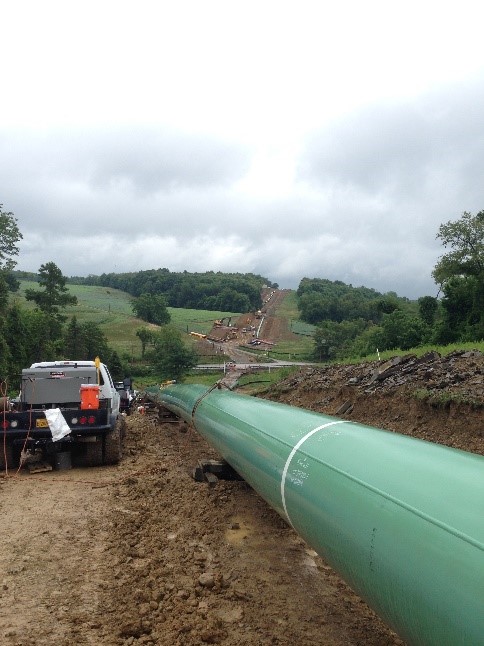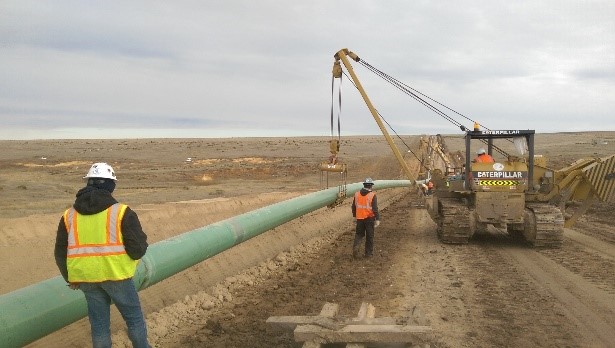Signs You May Need Immediate Help From Creek Pipe trenching services
A Deep Study Pipes Installation: Essential Variables and Considerations for Effective Projects
Efficient pipe installation is a vital facet of engineering tasks. It includes a series of variables, from material option to specific sizing and design. Each decision can notably affect the system's performance and longevity. Recognizing these elements is important for staying clear of expensive errors. Creek Pipe reviews. As groups navigate with the complexities of installation, a number of essential considerations emerge that warrant interest. What are the crucial elements that can make or damage a piping project?
Recognizing Pipe Products and Their Applications
When picking pipe products, one need to consider the specific applications and ecological conditions they will face. Different products use distinctive homes that accommodate numerous needs. PVC is light-weight and immune to rust, making it optimal for water circulation systems. Conversely, steel pipelines offer stamina and durability, appropriate for high-pressure applications but might call for safety layers to prevent rust.Copper pipes are preferred for pipes as a result of their antimicrobial residential properties and ease of installation, while polyethylene is usually made use of in below ground applications as a result of its flexibility and resistance to cracking.The option of product also depends upon temperature level extremes, chemical exposure, and installation location. For high-temperature applications, materials like CPVC or PEX can be beneficial. Ultimately, recognizing the features and restrictions of each material aids in making notified choices that boost system effectiveness and durability.
Value of Appropriate Sizing and Layout
Appropriate sizing and layout of pipes are essential for making certain excellent circulation rates and lessening pressure loss. These factors also play a significant role in establishing the compatibility of products utilized in the installation. A methodical technique to sizing and style can significantly boost the efficiency and durability of a piping system.
Influence On Flow Rates
Flow rates in piping systems are critically influenced by the sizing and style of the pipelines. Correctly sized pipes ensure that the liquid can relocate successfully, lessening turbulence and taking full advantage of circulation capacity. Oversized pipes can lead to lowered circulation speeds, while small pipes may limit circulation, leading to enhanced friction and prospective clogs. The design should also consider factors such as pipe material, internal surface area level of smoothness, and design, as these add to the total efficiency of fluid transportation. In addition, the plan of fittings and links within the system can influence circulation prices. Careful focus to pipe sizing and style is vital for maximizing circulation efficiency in any piping installation project.
Pressure Loss Factors To Consider

Just how can press loss significantly influence the effectiveness of a piping system? Stress loss is a crucial element that can substantially reduce the performance of fluid transport systems. When pipes are incorrectly sized or developed, extreme pressure loss may occur, leading to decreased circulation prices and increased power usage. This ineffectiveness can cause higher functional expenses and possible system failings. Appropriate sizing and layout are necessary to lessen pressure loss, making certain that liquid dynamics remain optimal throughout the system. Engineers have to thoroughly consider variables such as pipe diameter, length, and material to achieve an effective equilibrium. Eventually, resolving pressure loss throughout the style stage can enhance dependability and longevity, making it essential for effective piping projects.
Material Compatibility Aspects
Pressure loss is not the only aspect that can impact the performance of a piping system; material compatibility likewise plays a substantial duty in total performance. Making certain that the products made use of in a piping system are compatible with the fluids they will certainly transport is crucial. Various products can respond negatively to different chemicals, leading to deterioration, degradation, or contamination. This can eventually endanger the integrity of the system and impact its long life. In addition, proper sizing and layout are very important to accommodate thermal growth and tightening, which can further affect material efficiency. Reviewing aspects such as temperature level, stress, and chemical composition is vital in choosing proper products, thus boosting system dependability and decreasing upkeep expenses in the long-term.
Strategies for Accurate Pipe Installation
Precise pipe installation is essential for guaranteeing system effectiveness and long life. Numerous techniques can enhance the precision of this procedure. First, mindful dimension is important; installers must make use of quality tools such as laser degrees and tape steps to figure out the exact lengths and angles called for. Next off, correct pipe cutting techniques, like utilizing a pipe cutter rather than a hacksaw, warranty tidy edges that assist in much better connections. Additionally, using placement tools, such as pipe jigs, can notably enhance accuracy during setting up. It is likewise a good idea to take into consideration thermal growth; permitting ample spacing and growth joints can prevent future misalignments. Ultimately, the installation group should adhere to producer standards to follow details referrals related to each pipe kind. By carrying out these strategies, the possibility of leakages and system failings decreases, eventually contributing to a more reliable piping system.
Guaranteeing Pipe Positioning and Assistance
Correct alignment and support are crucial to the stability and performance of any piping system. Imbalance can result in boosted stress on joints, potential leakages, Find Out More and minimized performance. To assure appropriate positioning, it is crucial to utilize ideal devices such as laser degrees and positioning assesses. These instruments assist accomplish precise positioning, ensuring that pipes are set up in conformity with design specifications.Support systems should be created to accommodate thermal growth and tightening, along with the weight of the pipes and their materials. Selecting the appropriate kind of Discover More supports, hangers, and brackets is crucial. Each need to be installed at defined periods to stop drooping or undue stress on the pipes. Routine assessments following installation can help recognize any type of imbalances or indications of insufficient support. By focusing on alignment and support, one can considerably enhance the sturdiness and functionality of the piping system.
Typical Installation Mistakes to Stay Clear Of

Checking and Inspection for Quality Control
The installation process might appear full, detailed testing and evaluation are essential to making sure the long-term dependability of a piping system. Different techniques are used to analyze the honesty of the installation, including pressure examinations, aesthetic examinations, and main water line to house non-destructive testing (NDT) techniques. Stress examinations validate that the system can stand up to functional conditions without leaks, while aesthetic assessments assist identify any kind of visible defects in the pipelines or joints. NDT methods, such as ultrasonic or radiographic testing, provide insights right into the product integrity without compromising the system.Additionally, recording the testing results is vital for future recommendation and compliance with industry standards. This documents offers not only as a quality control action however likewise as a lawful secure. Inevitably, a detailed screening and assessment procedure contributes to the total security and performance of the piping system, guaranteeing it satisfies the required efficiency requirements with time.
Maintenance Tips for Durable Pipe Systems
Keeping a pipe system calls for normal evaluations and checking to identify prospective problems before they intensify. Carrying out efficient cleansing methods is likewise crucial for protecting against build-up that can prevent efficiency. With each other, these techniques add to the longevity and reliability of the piping infrastructure.
Regular Inspections and Monitoring
Routine evaluations and tracking are necessary for making sure the durability and efficiency of pipe systems. Regular assessments can aid recognize possible concerns such as leaks, rust, or blockages before they rise right into substantial troubles. Applying a timetable for regular inspections enables the very early discovery of deterioration, enabling prompt fixings. Surveillance pressure levels and flow rates can additionally offer useful understandings into system performance, ensuring that any abnormalities are resolved promptly. Furthermore, the use of sophisticated modern technologies, such as infrared cams or ultrasonic testing, can enhance the evaluation process by giving thorough info regarding pipe problems. Eventually, consistent monitoring and inspections add to the integrity and resilience of pipe systems, decreasing the danger of costly repair work and downtime.

Efficient Cleaning Techniques
Effective cleaning methods are important for maintaining the honesty and capability of pipe systems. On a regular basis arranged maintenance, such as flushing systems with water, aids remove particles and buildup. For even more stubborn clogs, experts often suggest hydro jetting, which uses high-pressure water to tidy pipe insides completely. Chemical cleansers can likewise be made use of however need to be selected meticulously to avoid destructive pipes. Furthermore, using tools like pipe cams can aid in recognizing problem areas and making certain efficient cleansing. Keeping proper water drainage and avoiding the disposal of damaging substances down pipelines further contribute to durability. On the whole, consistent cleansing practices not just boost efficiency but additionally reduce the danger of costly fixings in the future.
Often Asked Inquiries
What Are the Labor Prices Related To Pipe Installation Projects?
Labor costs for pipe installation jobs vary commonly, affected by variables like task intricacy, neighborhood wage rates, and required skills (Creek Pipe HDPE installation). Commonly, these costs can range from $50 to $100 per hour, depending on the workforce involved
Exactly How Do Regional Laws Affect Pipe Installation Practices?
Regional guidelines substantially affect pipe installation techniques by developing safety and security criteria, product specifications, and installation methods. Compliance with these policies assurances task safety and security, environmental management, and adherence to regional codes, eventually impacting overall project success and prices.
What Devices Are Important for Pipe Installation?
Important tools for pipe installation include pipe wrenches, cutters, and installations. In addition, sealers, determining tapes, and degrees ensure accuracy and sturdiness. Appropriate equipment advertises performance and adherence to security standards during the installation process.
Just How Can Climate Issues Impact the Installation Process?
Weather problems considerably impact the installation process, as severe temperature levels, rainfall, or wind can impact product stability, worker safety and security, and task timelines. Appropriate planning and scheduling are vital to minimize these prospective difficulties during installation.
Are There Warranties for Installed Pipe Solutions?
Service warranties for mounted pipe systems usually differ by supplier and installation service provider. Commonly, they cover flaws and craftsmanship for a given period, ensuring the system's reliability and giving comfort to the homeowner.